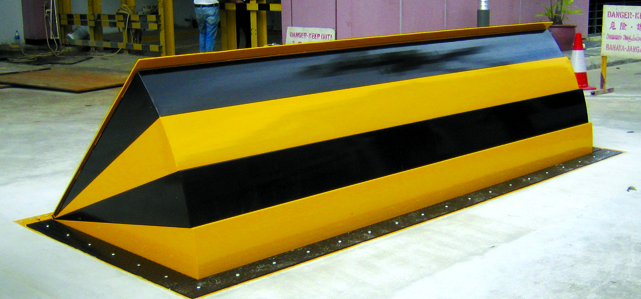The Buzz on Wedge Barriers
The Ultimate Guide To Wedge Barriers
Table of ContentsNot known Incorrect Statements About Wedge Barriers An Unbiased View of Wedge Barriers

The Main Principles Of Wedge Barriers
g., spring assistance 65 )may be fixed to completion of the springtime rod 58 to enable compression of the springs 60. As the springtimes 60 are compressed in between the spring supports 62, the springtime assembly 54 creates a force acting upon the cam combined to the springtime rod 58 in an instructions 66. The staying force applied to
the cam web cam deploy the wedge plate 16 may be provided given an electromechanical actuator 84 or other actuator. The springtime assembly 54 and the actuator 84(e. g., electromechanical actuator)may operate together to convert the cam and lift the wedge plate 16.
As discussed over, the springtime setting up 54 exerts a constant force on the webcam, while the electromechanical actuator might be regulated to apply a variable force on the cam, thus enabling the lifting and lowering( i. e., deploying and retracting )of the wedge plate 16. In specific embodiments, the consistent pressure used by the springtime setting up 54 might be flexible. g., electromechanical actuator) is impaired. As will certainly be valued, the springtime setting up 54 might be covered and secured from particles or various other aspects by a cover plate(e. g., cover plate 68 received FIG. 4) that may be significantly flush with the elevated surface 38 of the foundation 14. As discussed above, in the deployed setting, the wedge plate 16 offers to obstruct gain access to or traveling past the obstacle 10. The barrier 10(e. g., the wedge plate 16 )may block pedestrians or vehicles from accessing a residential or commercial property or pathway. As talked about above, the barrier 10 is connected to the anchor 30 protected within the structure 14,

front brackets 71. As an outcome, the affiliation settings up 72 may pivot and rotate to allow the collapse and expansion of the linkage assemblies 72 during retraction and release of the Homepage bather 10. The linkage assemblies 72 cause activity of the wedge plate 16 to be restricted. If a car is traveling towards the deployed wedge plate 16(e. For example, in one situation, the security legs 86 may be extended duringmaintenance of the barrier 10. When the safety legs 86 are deployed, the safety and security legs 86 sustain the weight of the wedge plate 16 versus the surface area 12. Because of this, the lifting mechanism 50 may be deactivated, serviced, eliminated, changed, etc. FIG. 5 is partial viewpoint sight of a personification of the surface-mounted wedge-style barrier 10, illustrating the webcam 80 and the cam surfaces 82 of the training device 50. Especially, 2 camera surfaces 82, which are referred to as lower webcam surfaces 83, are positioned below the cam 80. The lower cam surfaces 83 may reference be fixed to the surface 12 (e. As an example, the lower cam surface areas 83 and the mounting plate 85 might create a solitary piece that is secured to the support 30 by bolts or various other mechanical bolts. Furthermore, two web cam surface areas 82, which are referred to as top camera surfaces 87, are placed over the webcam 80 and coupled to (e. In various other embodiments, interfering layers or plates might be positioned in between the surface 12 and the lower web cam surfaces 83 and/or the wedge plate 16 and the upper camera surfaces 87 As stated above, the cam
80 converts along the camera surfaces 82 when the wedge plate 16 is raised from the withdrawed setting to the released setting. Additionally, as pointed out over, the spring assembly 54 (see FIG. 3 )might give a force acting upon the cam 80 in the direction 102 via springtime pole 58, which might lower the pressure the electromechanical actuator 84 is needed to apply to the camera 80 in order to actuate and lift Going Here the wedge plate 16. 1 )to the released position(see FIG. 4). As shown, the web cam 80 includes track wheels 104(e. g., rollers), which get in touch with and convert along the webcam surface areas 82 throughout operation.